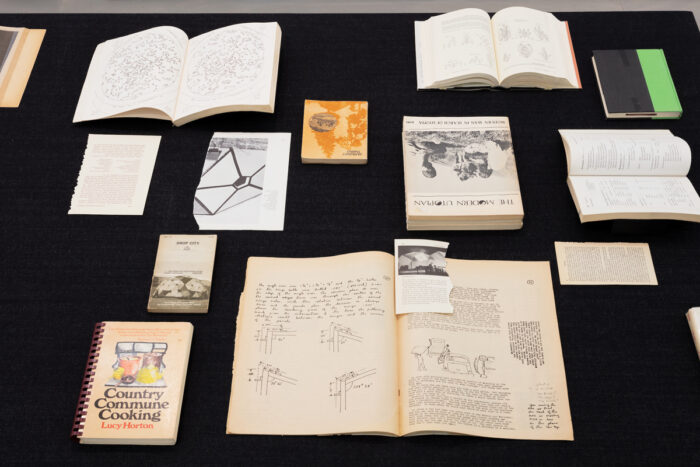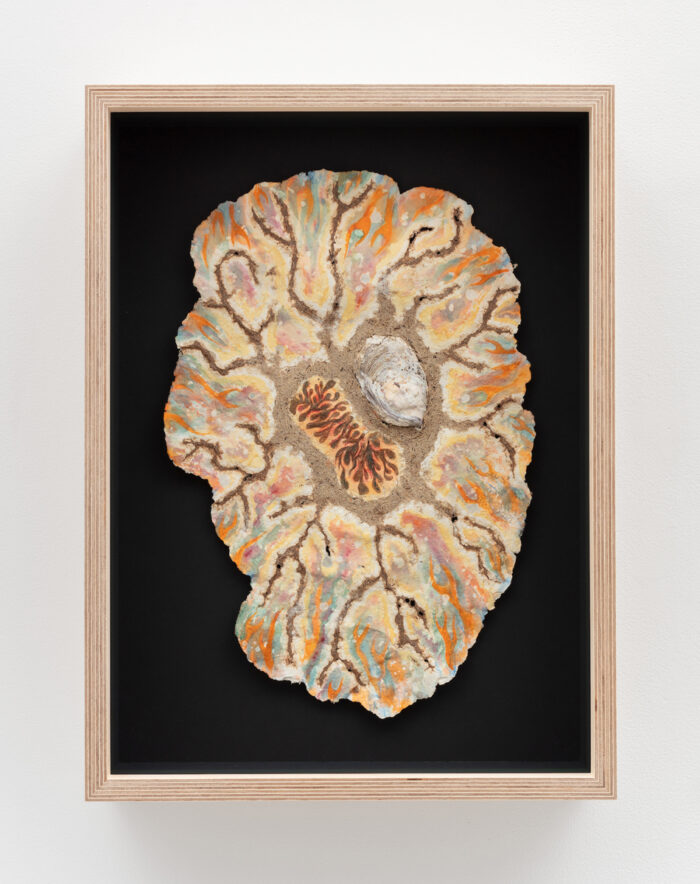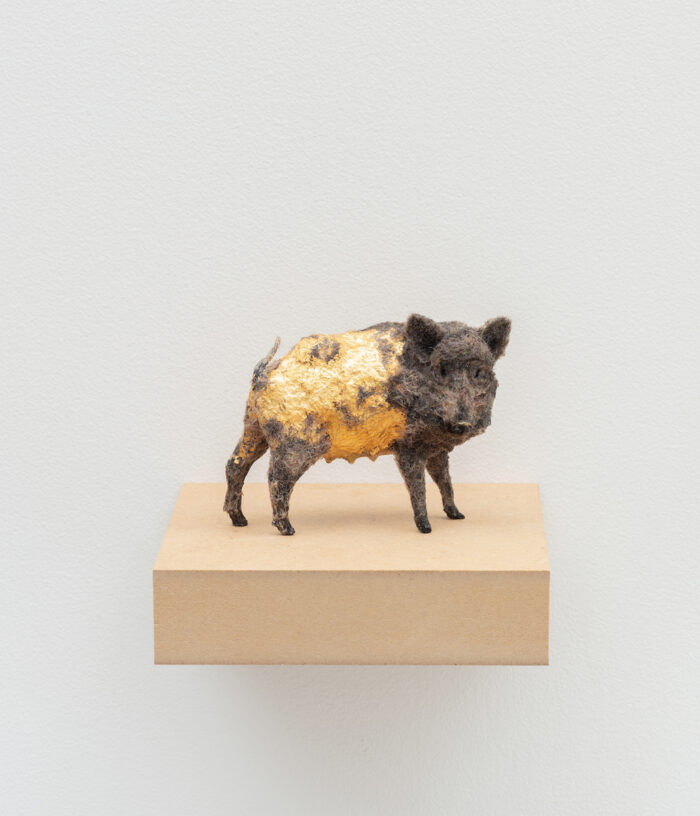







“The Green Ray” Group Show at 47 Canal
8 Apr to 8 May 2021
All Images courtesy of 47 CANAL
“The Green Ray” reflects on heightened states of presence, stasis, and local enmeshment.
Returning to the landscape and built environment as themes, the works in this exhibition
cultivate perspectives from the ground, glimpsing at fragments of a horizon that continues to alter and shift in absence of any clear direction. Where the horizon has often stood in for a kind of distinctive futurity, “The Green Ray” focuses instead on the acts of looking around intently, like searching for the elusive (and eponymous) optical phenomenon at sunset, and piecing together what has been here and is always near.
Martin Beck’s work Incomplete Parts (version) (2012) is an arrangement comprised of vintage books on communal living, all published between 1968 and 1980, a period in American history when countercultural communities initially thrived. Arranged together atop a denim-bound table, syntax of iconic motifs emerge from the covers and spreads. The visual and verbal rhetoric, associated with an oft-romanticized “back to the land” movement (led predominantly by white people), is interrupted here by emblematic pages that Beck ripped out when reading these books. He points to this quote by Patsy Richardson: “Sometimes … most times … communes fail. So do the world’s big institutions … but they go on and on, like the walking dead. At least communes know when and how to die, leaving a little residue of wisdom behind like seed.”
Enmeshed in the fibers of Amy Lien and Enzo Camacho’s small drawings are foraged plant
matter and other site-specific materials. Fibrous sugarcane pulp from a sugar mill in the
Philippines, leftover cardamom seedpods and banana peels from meals, oyster shells and seed pearls from a wholesale market in Manila capture a reflexive itinerant practice. Using makeshift mesh frames and presses, Lien and Camacho’s series of handmade paper works began while researching the work of modernist painter Alfonso Ossorio on the island of Negros. The works Burning Bush (2020) and Inflammation (2020) evoke a series of wildly expressionistic drawings that the Filipino American artist produced during his own stay on the island, where Needs (2020) and Bird (2020) experiment with a new process of drawing and papermaking at home under lockdown.
Embarking upon a journey of introspection, Brook Hsu refers to her small paintings as “plein air interior landscapes.” Through the repetition of her oil compositions in green, depictions of a rolling landscape and a skeleton entombed stretch and shrink with the intimate size of each woodblock––destabilizing fixed notions of familiar imagery or representation against varying horizons. The unique sizes of these paintings––results of being off-cuts scavenged from her friends’ woodshops and industrially sourced construction planks––necessitate close and careful studying.
Hand-pressed ceramic tiles in Kahlil Robert Irving’s floor sculpture WONDER Land of many men, ro-man, Black and Black (2019) pay homage to the traversal of daily life in and out of the city. The seemingly placid surface of constellations belies the treacherous yet multitudinous space of the streets, which require attentive navigation. The work is also inspired by ancient Antioch mosaics from the 3rd Century A.D.––historical fragments that record the evolution of visual cues and storytelling from Greek to Roman periods. Presented here, asphalt and starry sky collapse in reference to the stories and myths embedded within each great expanse.
The selection of small animal sculptures in the exhibition is part of Wang Xu’s ongoing series Dream Animals. These works show the persistence of a practice dependent on ephemeral connections between shared spaces and personal memories. Departing from his previous films exploring collaborative labor and craft in built environments, Wang first began carving the sculptures outdoors in New York City parks. Employing a variety of sculpting methods––from hand carving and extruding to felting and gilding––the works appear enigmatic yet recognizable in their forms. They also mark a more introspective turn, inspired by visions in his dreams. Wang, who was mostly confined to his family’s apartment in Dalian, China last year, made his most recent addition to the series, Daydreamer (2020), while watching the neighborhood from his windows.
Martin Beck (b. 1963) lives and works in New York City. Recent solo exhibitions include: dans un second temps (2018) at Fonds régional d’art contemporain de Lorraine, Metz, France; Last Night (2018) at Bergen Kunsthalle, Bergen, Norway; and rumors and murmurs at the Museum Moderner Kunst Stiftung Ludwig Wien, Vienna. His work has also been included in group exhibitions at the Museum of Natural History, Vienna; Kunsthalle Wien, Vienna; Centre Cultural LLibreria Blanquerna, Madrid; Yale Union, Portland; Neues Museum, Nuremberg, Germany; and the Whitney Biennial, New York. Beck’s work is included in the public collections of CCS Bard Hessel Museum of Art, Annandale-on-Hudson, New York, and Museum Moderner Kunst Stiftung Ludwig Wien, Vienna, Austria.
Amy Lien (b. 1987, US) and Enzo Camacho (b. 1985, PH) have a collaborative artistic
practice that moves from the Philippines outwards to other places, addressing localized
iterations of labor and capital from the perspective of postcolonial damage. Their projects often involve an immersive period of research or living within a locale, during which they try to identify particular points of tension that speak to the selective disorganization of lives and worlds in the service of profit and development. Their installation waves move bile (2020) was recently included in Manifesta 13 Marseilles. Their work has also been presented at the NTU Centre for Contemporary Art, Singapore; Kunstverein Freiburg, Germany; the Hessel Museum of Art at Bard College, Annadale-on-Hudson, New York; the Jim Thompson Art Center, Bangkok; and the UCCA Center for Contemporary Art, Beijing, among others.
Brook Hsu (b. 1987) lives and works in New York. Solo exhibitions include: Blue Bunny at
Manual Arts, Los Angeles; Conspiracy theory at Et al., San Francisco (2019); pond-love,
Bortolami Gallery, New York (2019); Fruiting Body at Bahamas Biennale, Detroit (2018); Panic Angel at Deli Gallery, New York. Select group exhibitions include: More, More, More (curated by Passing Fancy), TANK, Shanghai (2020); Let Me Consider It from Here, The Renaissance Society, Chicago (2018-2019); STILL LIFE, CLEARING, New York (2020); The End of Expressionism, Jan Kaps, Cologne (2020); Polly, Insect Gallery, Los Angeles (2019-2020); A Cloth Over a Birdcage, Château Shatto, Los Angeles (2019); and Finders’ Lodge, in lieu, Los Angeles (2019). Upcoming exhibitions include a two-person exhibition at Et al. Gallery, San Francisco (2021); solo exhibition at Kraupa-Tuskany Zeidler, Berlin (2021); group exhibition Particularities (curated by Chris Sharp), X Museum, Beijing (2021); solo exhibition at Edouard Malingue, Hong Kong (2022); two-person exhibition with Emma Webster at Galeria Duarte Sequeira, Braga, Portugal. A monograph and edition is forthcoming from American Art Catalogues.
Kahlil Robert Irving (b. 1992, San Diego, CA) is an artist currently living and working in St.
Louis, Missouri. He attended the Sam Fox School of Design and Visual Art, Washington
University, St. Louis (MFA, 2017); and the Kansas City Art Institute (BFA, Art History and
Ceramics, 2015). In 2017, Callicoon Fine Arts mounted his first solo exhibition in New York titled Streets:Chains:Cocktails. Since then, his work has been exhibited at the Whitney Museum, in New York City; the Nerman Museum of Contemporary Art, Kansas; the Craft and Folk Art Museum, Los Angeles; and the RISD Museum, Rhode Island; and Wesleyan University’s Center for the Arts, among others. His work is in the collections of J.P Morgan Chase Art Collection, New York; Nerman Museum of Contemporary Art, Kansas; the Carnegie Museum of Art, Pittsburgh; and the Whitney Museum of American Art, New York. Irving was selected to participate in the 2019 Great Rivers Biennial hosted by the Contemporary Art Museum St. Louis, where he had a solo exhibition in May 2020.
Wang Xu (b. 1986, Dalian, China) received his BFA in sculpture from Central Academy of
Fine Arts, Beijing, before pursuing an MFA at Columbia University in New York City. Recent exhibitions include: Wang Xu: Garden of Seasons (2018) at the Vincent Price Art Museum, Monterey Park, CA; Seeds of Time (2017) Shanghai Project, Shanghai; In Response of Repetition and Difference (2015) at the Jewish Museum, New York; and Under Foundations (2015) SculptureCenter, New York. He is a 2018 resident of The Skowhegan School of Painting and Sculpture, and The Socrates Sculpture Park, New York.
